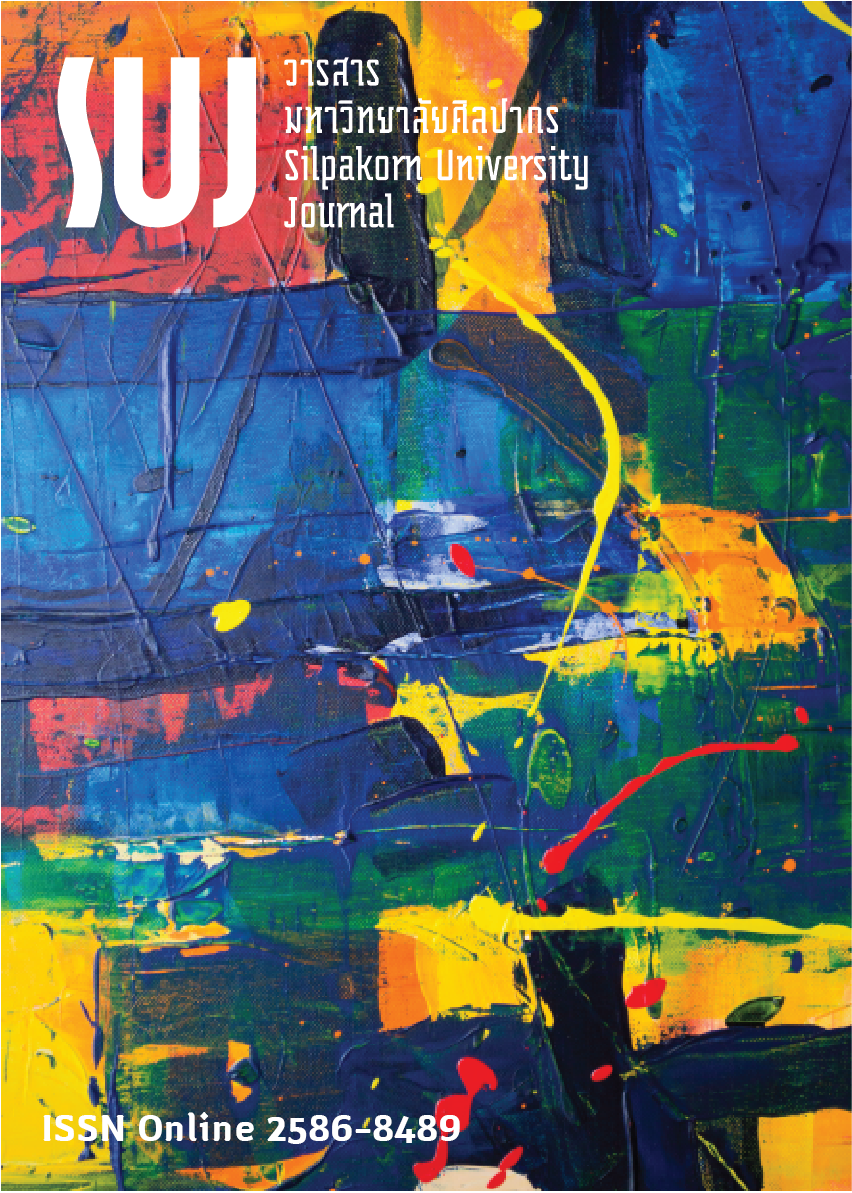องค์ประกอบทางสถาปัตยกรรม การเรียนรู้รูปแบบของเจดีย์ แนวทางจัดทำองค์ความรู้เพื่อจัดทำสื่อดิจิทัลการเรียนรู้ประวัติศาสตร์ศิลปะแนวใหม่ กรณีศึกษา : วัดเจดีย์เจ็ดแถว ศรีสัชนาลัย สุโขทัย (The architectural elements of stupa study for design a “new form of Art History digital learning tool” : case study Wat Chedi Chet Thaeo, Si Satchanalai, Sukhothai)
Main Article Content
Abstract
การวิจัยนี้มีวัตถุประสงค์เพื่อ 1) เพื่อศึกษาประวัติศาสตร์และอิทธิพลของศิลปะรอบ ๆ อาณาจักรสุโขทัยที่มีต่องานศิลปกรรมและสถาปัตยกรรมของอุทยานประวัติศาสตร์สุโขทัย-ศรีสัชนาลัย และมีอิทธิพลต่อแนวคิดการออกแบบวัดเจดีย์เจ็ดแถว 2) เพื่อศึกษาและเก็บบันทึกข้อมูลรูปแบบลักษณะของเจดีย์รวมถึงลวดลาย ปูนปั้นที่วัดเจดีย์เจ็ดแถว และนำมาใช้ในการสร้างรูปแบบสันนิษฐาน 3) เพื่อออกแบบโครงสร้างข้อมูลสำหรับสร้างรูปแบบการเรียนรู้ “ประวัติศาสตร์ศิลปะแนวใหม่” ผลการวิจัยพบว่า 1) เจดีย์มี 3 รูปแบบสำคัญคือ เจดีย์ทรงดอกบัวตูม เจดีย์ทรงปราสาท และเจดีย์ทรงระฆัง 2) องค์ประกอบสำคัญของเจดีย์คือส่วนฐาน ส่วนเรือนธาตุและเรือนยอด 3) ส่วนฐานเป็นฐานเขียงทรงสี่เหลี่ยมจัตุรัสซ้อนลดหลั่นกันไป 3-4 ชั้น 4) เจดีย์ทรงดอกบัวตูมและทรงปราสาทบางองค์มีช่องที่เรียกว่า “ช่องจระนำ” สำหรับประดิษฐานพระพุทธรูปได้รับอิทธิพลของศิลปะพุกาม มีการเพิ่มพื้นที่ด้านข้างทั้งสองด้านเรียกว่า “จระนำปีกนก” 5) ฐานบัวลูกฟักและฐานบัวลูกแก้วอกไก่เหนือฐานเขียง มีลักษณะการใช้ทดแทนกันได้ 6) ฐานเขียงย่อมุมและยกเก็จที่เรียงซ้อนเพื่อรองรับส่วนเรือนธาตุหรือเรือนยอด มีผลรูปทรงของเจดีย์สูงขึ้น 7) อิทธิพลทางศิลปะที่พบ เช่น เจดีย์ทรงดอกบัวตูมที่มีลักษณะส่วนปลายที่เรียกว่า “ปล้องไฉน” และ “ปลียอด” มาจากเจดีย์ทรงลังกา ซุ้มลดที่มีฝักเพกาที่เจดีย์ทรงปราสาท เรียกตามศิลปะพุกามว่า “ซุ้มเคล็ค” ฐานบัวลูกฟักจากศิลปะลพบุรี เจดีย์ทรงระฆังแบบล้านนาที่มีฐานบัวลูกแก้วอกไก่แบบมีมุมยกเก็จ 8) ลวดลายปูนปั้น เช่น ลายปูนปั้นที่บรรพแถลง (ลายหน้ากาล) กลีบขนุน (ลายครุฑยุดนาค) กรอบซุ้มคตโค้ง กรอบซุ้มหน้านาง ฝักเพกา และลายพันธุ์พฤกษา ลายดอกไม้ กลีบบัว ลายกระจังเป็นแถบรัดอกบริเวณส่วนกลางของทรงระฆัง และสี่เหลี่ยมหยักย่อมุมทรงเลขาคณิต เป็นต้น การออกแบบแอปพลิเคชันนี้เป็นส่วนหนึ่งของการสร้างรูปแบบ “การเรียนรู้ประวัติศาสตร์ศิลปะแนวใหม่” โดยให้ความสำคัญของการผสมผสานเทคโนโลยีและประวัติศาสตร์ศิลปะ เพื่อจูงใจให้คนสนใจเรียนรู้ประวัติศาสตร์ศิลปะ และใช้สื่อดิจิทัลในการศึกษาได้ง่ายและชัดเจนขึ้น
The objectives of this research are: 1) to study the history and influence of art in Sukhothai that affected the art and architecture of the Historic Town of Sukhothai-Si Satchanalai and influenced the design concept of Wat Chedi Chet Thaeo, 2) to study and record the current style and motifs of stupas, and 3) to design the architecture information for the “new form of art history learning” with digital media for easy understanding. The result of research found that: 1) there are 3 styles of stupas, namely lotus-bud style, Prasat style, and bell-shaped style. 2) The important elements of a stupa consist of 3 parts which are a base, the main body, and a finial. 3) The style and order of the pagoda base of most Chedis in temples are similar since they consist of 3-4 square bases receding toward the main body of a Chedi. 4) Some of lotus-bud-style Chedis and Prasart-style Chedis were built with the extension of the space to be a “niche” which was the house of a Buddha image. There are several Chedis that have a special form of niches from Pagan architecture. It was the extra vault of the niches beside the main niche. 5) Bua fillet moulding bases (Bua Look Fak) and pointed torus moulding bases (Bua Look Kaew Oak Kai) were found and interchangeably used on the base and body section of pagodas in both Sukhothai and Si Satchanalai. 6) Redented symmetrical base tiers are mainly used to increase the height of a stupa. The consequence was that the contour of a pagoda up to the apex is more beautiful. 7) The influence of art was found in each stupa. For instance, the top finial which was adopted and modified from the bell-shape style of Singhalese or Pagan art. The porticos of diminishing proportions on Prasart-style Chedis were adopted from Pagan and found in Lanna art. According to the synthesis and analysis of the information, the researcher found that we should have more understanding of the archeological terminology which will assist the learner to understand the ancient architecture under the idea of the “new form of art history learning”. This research integrates the latest available technology with historical information to recreate the learning process and historical tourism in order to bring the site back to life once again.
Downloads
Article Details

This work is licensed under a Creative Commons Attribution-NonCommercial-NoDerivatives 4.0 International License.
References
Damrongrajanupap. (1928). Declamation at Samakayacharn on “Motivation in Building Temple in Thailand” (มูลเหตุแห่งการสร้างวัดในประเทศสยาม แสดงเป็นปาฐกถาที่สามัคยาจารย์). [Online]. Retrieved June 20, 2019 from https://www.bloggang.com/mainblog.php?id=rattanakosin225&month=23-03-2007&group=2&gblog=42
Kuphanumat, Chalongdej. (2014). A Study on Buddhist Cosmology Conception in Lan Na Paintings for the Creations of Contemporary Arts (การศึกษาแนวคิดคติจักรวาลวิทยาในพระพุทธศาสนา จากงานจิตรกรรมล้านนาเพื่อการสร้างสรรค์ศิลปะร่วมสมัย). Silpakorn University Journal, 34(3): 17-42.
Leksukhum, Santi. (1991). Sukhothai’s Stupa at Wat Chedi Chet Thaeo (เจดีย์สมัยสุโขทัย ที่วัดเจดีย์เจ็ดแถว). Bangkok: Aksorn Sampun.
Leksukhum, Santi. (2010). Craftsmanship Glossary of Art Terminology (งานช่าง คำช่างโบราณ). Bangkok: Roong Silpa Printing.
Leksukhum, Santi. (2018). Sukhothai Kingdom : Chedi in Colors (สมัยสุโขทัย เจดีย์อินคัลเลอร์). Bangkok: Matichon Publishing.
Mendoza, A. (2013). Mobile User Experience : Pattern to Make of it All. Burlington, Massachusetts: Morgan Kaufmann Publishers.
Rattanapaiboon, Apirat. (2018). What is UI UX? : UX is significant and it is heart of design (UI UX คืออะไร : UX สำคัญมากและเป็นหัวใจของการออกแบบ). [Online]. Retrieved August 25, 2019 from https://medium.com/@apirat/ui-ux-d2a5889f92bc
Thailand Archaeological Database. (2006). City of Si Satchanalai (เมืองศรีสัชนาลัย). [Online]. Retrieved August 12, 2019 from https://www.sac.or.th/databases/archaeology/archaeology/ศรีสัชนาลัย


